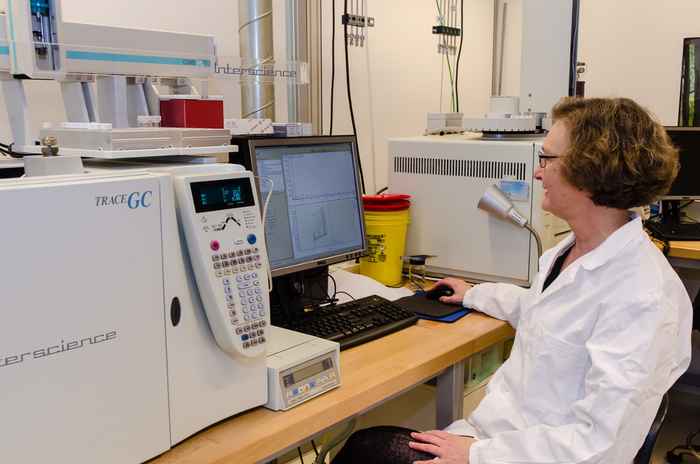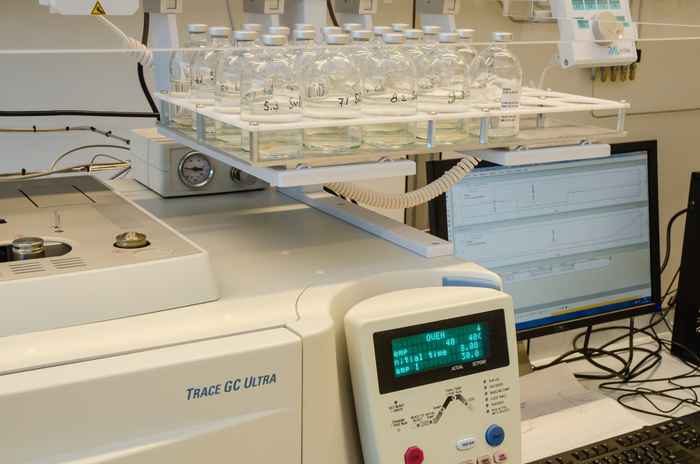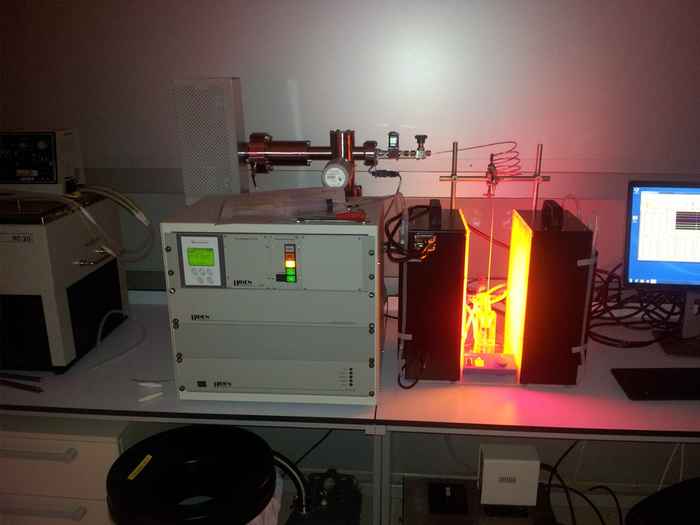Chromatography and mass spectrometry

HPLC-UV/fluorescence detector
The high-performance liquid chromatograph system is equipped with both a general-purpose UV detector and highly sensitive and selective fluorescence detector (HPLC-UV/Flu). The system is typically used for the analysis of a wide variety of water-soluble compounds within natural samples (e.g. water, soil and plants) or used in degradation or sorption studies. Typical applications include PAH analysis for bioremediation and sorption experiments, plant pigments and toxins, (degradation products of) herbicides, fullerenes, and phenolic acids within soil.
-
Technical Specifications
- Chromatography: HPLC Prominence, equipped with a binary LC-20AD pumping system, SIL-20 autosampler and CTO-20 column oven (Shimadzu, Kyoto, Japan).
- Detection: SPD-M20A photodiode array detector (PDA) and RF-10 XL fluorescence detector (Shimadzu, Kyoto, Japan).

UPLC-timsTOF
The Bruker timsTOF Pro 2.0 system is used for non-target screening and monitoring of a wide variety of chemicals in the environment. The system is equipped with a dual trapped high resolution ion mobility mass spectrometer (TIMS-MS) with Parallel Accumulation Serial Fragmentation (PASEF) and accurate and reproducible CCS determination, and a VIP HESI source. It can accomplish highly sensitive and fast acquisition of fragmentation MS data (MS/MS). With the system PASEF DDA scan speeds up to 100 Hz can be reached and can perform DIA analysis with mass and ion mobility window stepping.
Typical analyses within IBED include:
- Emerging contaminants in the environment, e.g. pesticides, pfas, flame retardants and pharmaceuticals and their degradation products.
- Plant, soil and aquatic organism constituents
- Root exudate metabolome to study chemical communications between plants and soil organisms
- Biodegradation studies
- Non-target screening, DOA, emerging contaminants
-
Technical Specifications
- Chromatography: UHPLC Nexera, equipped with a binary LC-40AD XS gradient pumping system, SIL-40C XS autosampler, CTO-40A column oven, SPD-40 UV detector and SCL-40 controller (Shimadzu, Kyoto, Japan).
- Detection: Bruker timsTOF Pro 2.0 system, a dual trapped high resolution ion mobility mass spectrometer (TIMS-MS) with Parallel Accumulation Serial Fragmentation (PASEF) and accurate and reproducible CCS determination, equipped with a VIP HESI source

Liquid chromatography UPLC-QTOF
For non-target and suspect target screening our ultra-performance liquid chromatography quadrupole time of flight (UPLC-QTOF) system is very well suited. The combination of high chromatographic resolution, mass resolving power and mass accuracy, MS/MS and isotopic pattern fingerprinting, allows this instrument to identify and characterize chemicals even within complex sample material. The system can be equipped with several ion sources (ESI, APCI, APPI and IonBooster). Furthermore, Direction Injection Probe (DIP) can be used for direct analysis of both solid and liquid samples.
Recent work includes the characterization of (degraded) perfluorinated polymers and screening for degradation products of aryl organophosphorus flame retardants.
-
Technical Specifications
- Chromatography: Nexera UHPLC system (Shimadzu, Kyoto, Japan), equipped with a binary LC-30AD gradient pumping system, a LC-20AD dopant delivery pump, SIL-30AC autosampler and CTO-20AC column oven.
- Detection: SPD20-A UV detector (Shimadzu, Kyoto, Japan) and maXis 4G Q-TOF MS (Bruker Daltonics, Bremen, Germany).

Trace gas chromatography GC-FID/mass spectrometry
This is a gas chromatography mass spectrometry (GC-MS) system with both cold-on-column and split/splitless injectors and the possibility to perform headspace and large volume analysis. It is equipped with a PAL autosampler.
This system can be used for the analysis of phospholipid fatty acids, lignin, volatile organic compounds such as BTEX, pesticides, brominated flame retardants, PCB’s etc.
-
Technical specifications
- ThermoQuest Trace GC 2000 gas chromatograph with Finnigan
- Trace MS quadrupole mass spectrometer, Milan, Italy
Dual pyrolysis-2GC-2(HR)MS gas chromatography mass spectrometry
A recent addition to our chromatography facilities is our dual QOrbitrap Exactive gas chromatography mass spectrometry (GC-MS) system. This is a multifunctional system with 2 GC-MS systems, a GC-HRMS and a quadrupole GC-MS system, with a combined Triplus injection system. Injection techniques include cold-on-column, split/splitless and headspace injection, and both systems can be equipped with a multishot pyrolysis unit.
A wide range of compounds can be measured on the systems. Prior research includes pesticide, lipids and bromated flame retardants in various matrices. Pyrolysis is used to characterize soil organic matter and plant material, and for nano and microplastic identification.
-
Technical specifications
- Multi-shot furnace pyrolyser (EGA/Py-3030D; Frontier Lab, Japan)
- 2 Thermo Scientific Trace 1300 Gas Chromatographs (Milan, Italy)
- Thermo Scientific ISQ 7000 Single Quadrupole Mass Spectrometer
- Thermo Scientific Exactive qOrbitrap Mass Spectrometer

Trace gas chromatography GC Ultra with TCD, ECD and FID detection
Used for the analyses of permanent gasses: carbon dioxide, nitrous oxide and methane in gaseous samples originating from field-sites or lab incubation experiments and for the measurement of acetylene and ethylene in incubated samples.
-
Technical specifications
- ThermoQuest Trace GC 2000 gas chromatograph with TCD, ECD and FID detectors, Thermo Scientific, Milan, Italy
- Equipped with PAL autosampler.

Membrane Inlet Mass Spectrometry (MIMS)
In our laboratory we have a Hiden HPR-40 Membrane Inlet Mass spectrometer installed with a mass range of 200 amu (atomic mass unit) with a dissolved species probe. This allows for accurate measurements of a wide range of gasses either in gaseous or dissolved in liquid environments. Using stable isotopes specific changes in conditions applied can be quantified. The probe is positioned in a specialised cuvette.
Typical applications of the MIMS in our lab are:
-
13C-labeled bicarbonate or carbon dioxide uptake
experiments to quantify rates of carbon fixation in cyanobacteria and algae.
- 18O2 uptake experiments to quantify oxidation or respiration rates during photosynthesis in cyanbacteria and algae.
-
Technical specifications
- Hiden analytical HPR-40 Membrane mass spectrometer
- HAL201 RC mass spectrometer with Faraday/Multiplier detector
- Mass range 200 amu
- Dissolved species probe type 303416
Contact information
Please contact us for more information: IBED-lab-science@uva.nl
